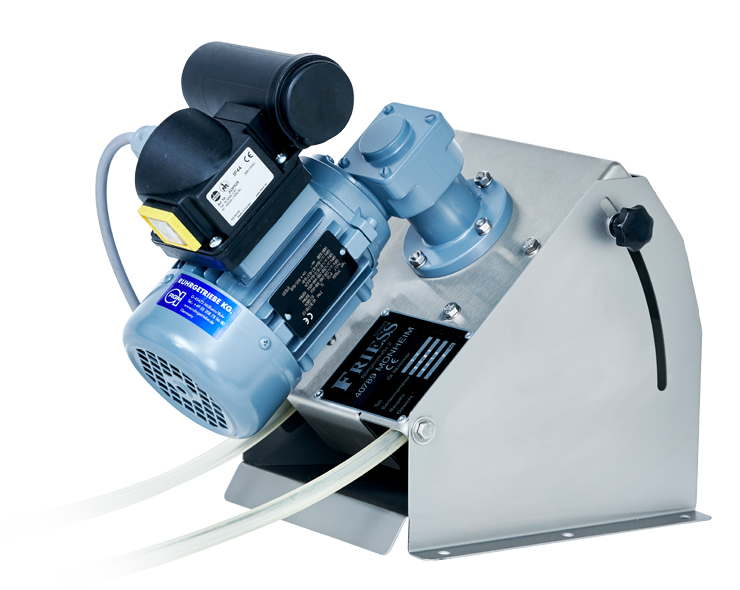Removal of Tramp Oil from CoolantIncreasing the Service Life of Coolant by Removing Tramp Oil from Coolant Tanks
A large manufacturer of printing machines uses approximately 300 machine tools to produce their parts. Each of these machine tools has its own coolant tank and filter system.
The Problem
Different materials are machined on the machine tools such as stainless steel, steel and cast iron. Especially machine tools machining cast iron, the coolant is heavily contaminated with cast iron chips, dust, graphite, hydraulic oil, lubricating oil and other oils. These contaminants form a thick sticky sludge that floats on and covers the cutting fluid surface. Therefore the coolant does not have any contact with oxygen in the air, which in turn resulted in an increase of bacteria in the coolant. Thus the coolant needed to be exchanged.
In order to contain the growth of anaerobic bacteria and thus increase the service life of the coolant, various systems were used. Since the germ load was significantly lower in the systems that were not contaminated with tramp oil, it was obvious to remove the tramp oil layer and thus achieve a longer service life of the coolant.
The belt skimmers that were initially used did not show the desired success. Due to the principle of operation, only a very small area of about 20 cm in diameter could be kept oil-free with these oil skimmers. Since the floating oil is very heavily loaded with graphite and microchips, the floating layer is so viscous that it cannot flow towards the oil skimmer without additional flow.
Initially, an improvement in the bacterial load was registered for a short time. However, due to the heavy particle contamination of the oil, the first malfunctions occurred in the systems used after a relatively short period of use. The plastic components used wore out very quickly due to abrasion. In addition, there were repeated blockages in the area of the scrapers and drain pipes. The solids carried along with the oil or emulsion settled as sticky sludge on the scrapers and thus blocked the drain of the belt skimmers.
The Solution

To avoid further repairs and frequent changes of the cooling lubricant used, a FRIESS oil skimmer model 1U was first used as a trial. This unit works according to a completely different operating principle than the familiar oil skimmers with a belt or disc. An endless oil collector tube floats on the surface of the liquid. This oil collector tube is set in motion by the oil skimmer.
Floating oils stick to the outside of the oil collector tube and are drawn into the oil skimmer with the oil collector tube. The scrapers in the oil skimmer remove the oil from the surface of the oil collector tube. The clean oil collector tube is transported back to the water surface and collects new oil. The oil scraped off by the scrapers falls downwards via a short chute into a collection container provided.
The oil collector tube reaches the entire surface of the tank. As a result, the oil is removed over a large area, not just locally. Due to the uniform rotary movement of the oil collector tube, the fluid surface is also set into a slight rotary movement. As a result, even very viscous, sticky oil or individual lumps of grease enter the pick-up area of the oil collector tube and are carried along by it. This results in an almost oil- and dirt-free surface of the coolant.
Since the conveyed oil can fall vertically from the scrapers, sticking and clogging are reliably avoided in the oil skimmers and regular maintenance work can be dispensed with. Since all components of the oil skimmer that come into contact with the heavily loaded oil collector tube are made of either highly abrasion-resistant ceramic or hardened steel, wear is extremely low despite the high dirt load of the cooling lubricant.
Result

Due to the almost oil-free surface, the coolant is now constantly in contact with oxygen. The germ load could be reduced considerably. The service life of the coolant was increased from a few weeks to up to 1 year. The tramp oil content in the coolant is less than 0.5 %. The frequent maintenance work previously required, such as suctioning the surface of the coolant or changing the coolant, has been significantly reduced.
- Cleaning and maintenance work on the oil skimmer is now only required once a year when the cooling lubricant is changed.
- This resulted in an extremely quick return on investment after less than 6 months for the FRIESS oil skimmer 1U.
